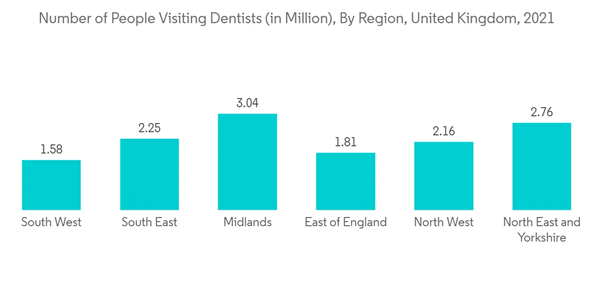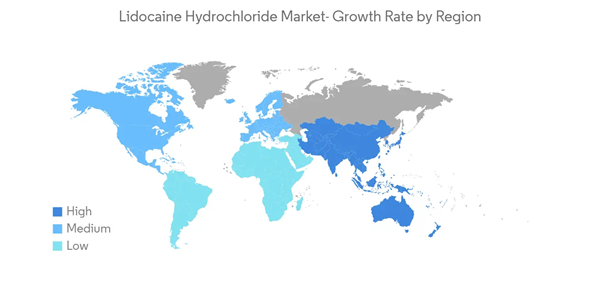The lidocaine hydrochloride market size is expected to record a CAGR of 4.1% during the forecast period.
COVID-19 had an impact on the growth of the market during the pandemic period owing to the potential anesthetic and anti-inflammatory properties of lidocaine in COVID-19. For instance, according to the Springer article published in March 2021, it was proposed that nebulized lidocaine might be beneficial in reducing cytokines, protecting patient's lungs, and improving outcomes in COVID-19 patients when administered via inhalation as an adjunctive treatment for severe respiratory symptoms in patients fighting the novel coronavirus. Thus, the potential benefits of lidocaine hydrochloride in the treatment of COVID-19 patients had an impact on the growth of the market. Moreover, the relaxation of strict regulations on surgical procedures in the post-pandemic period and the resumption of services are expected to drive the demand for lidocaine hydrochloride, thereby boosting market growth over the forecast period.
The increase in the number of surgical procedures performed worldwide, including dental procedures, cosmetic surgeries, and plastic surgeries, is expected to promote growth owing to the vast anesthetic usage of lidocaine hydrochloride in the surgeries. In addition, the rise in chronic and acute pain-related disorders and various benefits associated with lidocaine hydrochloride are some of the major factors driving the market growth. For instance, as per the Aesthetics Society 2021 report, there were around 3.2 million aesthetic procedures performed in 2021 in the United States. Additionally, the prevalence of pain-related disorders such as epilepsy and heart arrhythmia among the global population is also one of the driving factors for the growth of the market owing to the anti-inflammatory and pain reduction properties of lidocaine hydrochloride. For instance, as per the WHO data published in February 2022, around 50 million people worldwide have epilepsy, and an estimated 5 million people are diagnosed with epilepsy each year. Furthermore, additionally, the NCBI article published in May 2021 mentioned that in Europe, prevalent atrial fibrillation cases were expected to reach 14 million by 2060. Such prevalence of target diseases among the global population is expected to drive the growth of the studied market over the forecast period.
Additionally, the rising product launches by various market players are also expected to contribute to the growth of the market over the forecast period. For instance, in April 2022, Alembic Pharmaceuticals, wholly-owned Aleor Dermaceuticals, received final approval from the United States Food and Drug Administration for Lidocaine for use on normal intact skin for local analgesia and genital mucous membranes for superficial minor surgery. Further, owing to their safety profile and proven efficacy, lidocaine patches have been recommended as first-line therapy for the treatment of neuropathic pain in older patients, as well as those suffering from shingles, and this is expected to boost the market growth during the forecast period. Therefore, due to the aforementioned factors, the lidocaine hydrochloride market is expected to grow over the forecast period. However, the risk associated with lidocaine hydrochloride is expected to restrain the growth of the market during the forecast period.
Additionally, the increasing number of dental consultations is also expected to contribute to the growth of the studied segment. For instance, the data published by NHS in 2022 mentioned that in England, nearly 15.8 million adults visited an NHS dentist till December 2021, and over 5.1 million children visited an NHS dentist by December 2021. Thus, the rise in dental visits is also expected to contribute to the growth of the studied segment, as lidocaine hydrochloride is used as a local anesthetic in dental procedures.
Furthermore, the growth of the market can be attributed to the increasing volume of various surgical and cosmetic procedures, advancements in surgical procedures, and the growing use of lidocaine hydrochloride in postoperative pain management. For instance, according to the aesthetic society report published in 2022, about 458,628 liposuction procedures, 362,346 breast augmentation procedures, and 146,761 breast implant removal procedures were performed among women in the United States in 2021. Also, as per the OECD data published in December 2022, in Canada, approximately 54,991 hip replacement surgical procedures were performed in 2021. Moreover, the expanding geriatric population is anticipated to drive the number of surgical procedures performed in the region, thereby promising growth over the forecast period. Thus, the factors mentioned above are expected to drive the market's demand for development of the market during the forecast period in this region.
This product will be delivered within 2 business days.
COVID-19 had an impact on the growth of the market during the pandemic period owing to the potential anesthetic and anti-inflammatory properties of lidocaine in COVID-19. For instance, according to the Springer article published in March 2021, it was proposed that nebulized lidocaine might be beneficial in reducing cytokines, protecting patient's lungs, and improving outcomes in COVID-19 patients when administered via inhalation as an adjunctive treatment for severe respiratory symptoms in patients fighting the novel coronavirus. Thus, the potential benefits of lidocaine hydrochloride in the treatment of COVID-19 patients had an impact on the growth of the market. Moreover, the relaxation of strict regulations on surgical procedures in the post-pandemic period and the resumption of services are expected to drive the demand for lidocaine hydrochloride, thereby boosting market growth over the forecast period.
The increase in the number of surgical procedures performed worldwide, including dental procedures, cosmetic surgeries, and plastic surgeries, is expected to promote growth owing to the vast anesthetic usage of lidocaine hydrochloride in the surgeries. In addition, the rise in chronic and acute pain-related disorders and various benefits associated with lidocaine hydrochloride are some of the major factors driving the market growth. For instance, as per the Aesthetics Society 2021 report, there were around 3.2 million aesthetic procedures performed in 2021 in the United States. Additionally, the prevalence of pain-related disorders such as epilepsy and heart arrhythmia among the global population is also one of the driving factors for the growth of the market owing to the anti-inflammatory and pain reduction properties of lidocaine hydrochloride. For instance, as per the WHO data published in February 2022, around 50 million people worldwide have epilepsy, and an estimated 5 million people are diagnosed with epilepsy each year. Furthermore, additionally, the NCBI article published in May 2021 mentioned that in Europe, prevalent atrial fibrillation cases were expected to reach 14 million by 2060. Such prevalence of target diseases among the global population is expected to drive the growth of the studied market over the forecast period.
Additionally, the rising product launches by various market players are also expected to contribute to the growth of the market over the forecast period. For instance, in April 2022, Alembic Pharmaceuticals, wholly-owned Aleor Dermaceuticals, received final approval from the United States Food and Drug Administration for Lidocaine for use on normal intact skin for local analgesia and genital mucous membranes for superficial minor surgery. Further, owing to their safety profile and proven efficacy, lidocaine patches have been recommended as first-line therapy for the treatment of neuropathic pain in older patients, as well as those suffering from shingles, and this is expected to boost the market growth during the forecast period. Therefore, due to the aforementioned factors, the lidocaine hydrochloride market is expected to grow over the forecast period. However, the risk associated with lidocaine hydrochloride is expected to restrain the growth of the market during the forecast period.
Key Market Trends
Dental Procedure Segment is Expected to Hold Significant Share in the Market During the Forecast Period
The dental procedure segment is expected to record a lucrative CAGR during the forecast period. This is primarily attributed to the extensive usage of lidocaine hydrochloride injectables in different dental surgical procedures. For instance, the article published in Nature Journal in July 2021 mentioned that the buccal infiltration technique using lidocaine plus lingual anesthesia might be a good alternative in anesthetizing mandibular premolar teeth before their extraction. An increase in the prevalence of dental disorders, coupled with the growing number of surgeries performed, is the key driving factor for this segment. For instance, as per the WHO data published in March 2022, severe periodontal diseases were estimated to affect around 14% of the global adult population. Similarly, the research study published in Frontiers in April 2021 mentioned that the overall pooled prevalence of dental caries was found to be 45.7% in East Africa. Such a high prevalence of various dental disorders is expected to drive the demand for lidocaine hydrochloride during treatment procedures, thereby boosting segment growth.Additionally, the increasing number of dental consultations is also expected to contribute to the growth of the studied segment. For instance, the data published by NHS in 2022 mentioned that in England, nearly 15.8 million adults visited an NHS dentist till December 2021, and over 5.1 million children visited an NHS dentist by December 2021. Thus, the rise in dental visits is also expected to contribute to the growth of the studied segment, as lidocaine hydrochloride is used as a local anesthetic in dental procedures.
North America is Expected to Hold Significant Share in the Market During the Forecast Period
North America is expected to show healthy growth in the market over the forecast period owing to the presence of major market players. The efficiency of lidocaine hydrochloride in various surgical procedures is expected to drive the growth of the market in this region. For instance, the data published by NIH in June 2021 mentioned that lidocaine helps numb the area during and after the liposuction surgery, and it may be the only anesthesia needed for the procedures. Such usage of lidocaine in surgical procedures is expected to contribute to the growth of the market in this region, attributed to the high volume of surgeries.Furthermore, the growth of the market can be attributed to the increasing volume of various surgical and cosmetic procedures, advancements in surgical procedures, and the growing use of lidocaine hydrochloride in postoperative pain management. For instance, according to the aesthetic society report published in 2022, about 458,628 liposuction procedures, 362,346 breast augmentation procedures, and 146,761 breast implant removal procedures were performed among women in the United States in 2021. Also, as per the OECD data published in December 2022, in Canada, approximately 54,991 hip replacement surgical procedures were performed in 2021. Moreover, the expanding geriatric population is anticipated to drive the number of surgical procedures performed in the region, thereby promising growth over the forecast period. Thus, the factors mentioned above are expected to drive the market's demand for development of the market during the forecast period in this region.
Competitive Landscape
The lidocaine hydrochloride market is moderately competitive and consists of several major players. Some of the key players include companies such as Alanza Inc, Amphastar Pharmaceuticals, Inc., Cirondrugs, Mahendra Chemicals, Medexim India, Merck KGaA, Nortec Qumica, and Pfizer Inc. Investment for the development of effective and long-acting products with lesser adverse effects and improving geographical penetration through partnerships and collaborations are the key strategies adopted by the companies to increase their market shares.Additional benefits of purchasing the report:
- The market estimate (ME) sheet in Excel format
- 3 months of analyst support
This product will be delivered within 2 business days.
Table of Contents
1 INTRODUCTION
4 MARKET DYNAMICS
5 MARKET SEGMENTATION
6 COMPETITIVE LANDSCAPE
Companies Mentioned (Partial List)
A selection of companies mentioned in this report includes, but is not limited to:
- Alanza Inc
- Amphastar Pharmaceuticals Inc.
- Cirondrugs
- Mahendra Chemicals
- Medexim India
- Merck KGaA
- Nortec Qumica
- Pfizer Inc.
- Scilex Holding Company
- Himatsu Pharmaceutical Co., Ltd
- Jiangsu Tianji Pharmaceutical Co Ltd
Methodology

LOADING...










